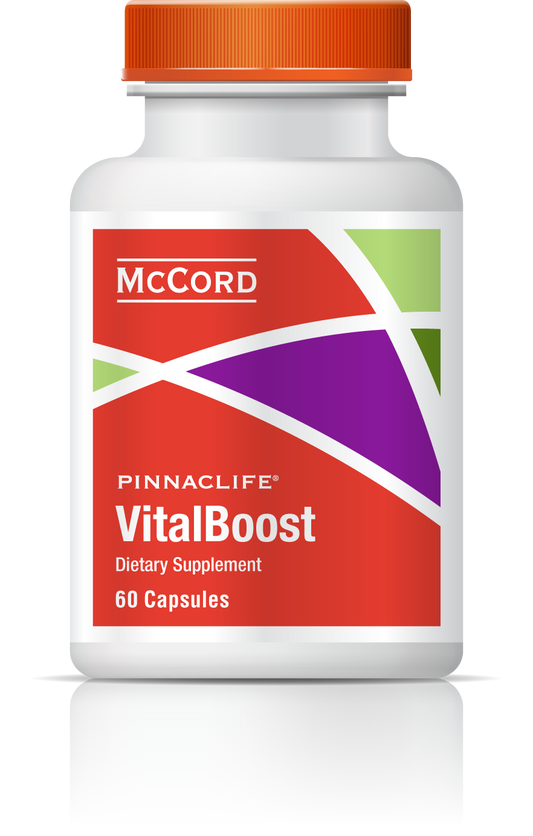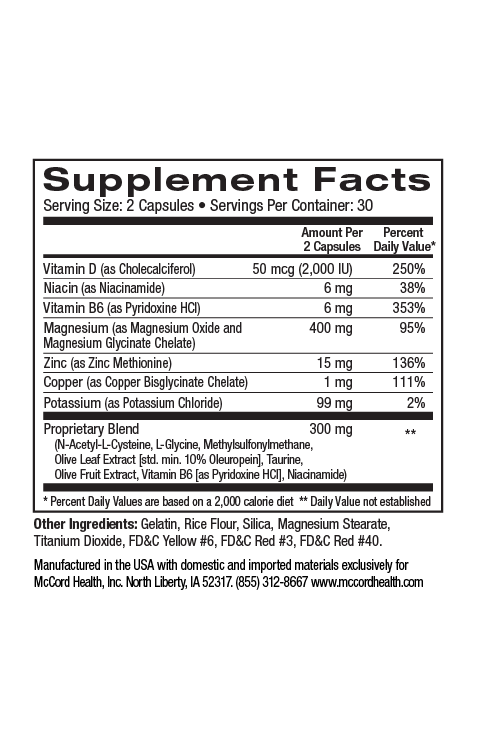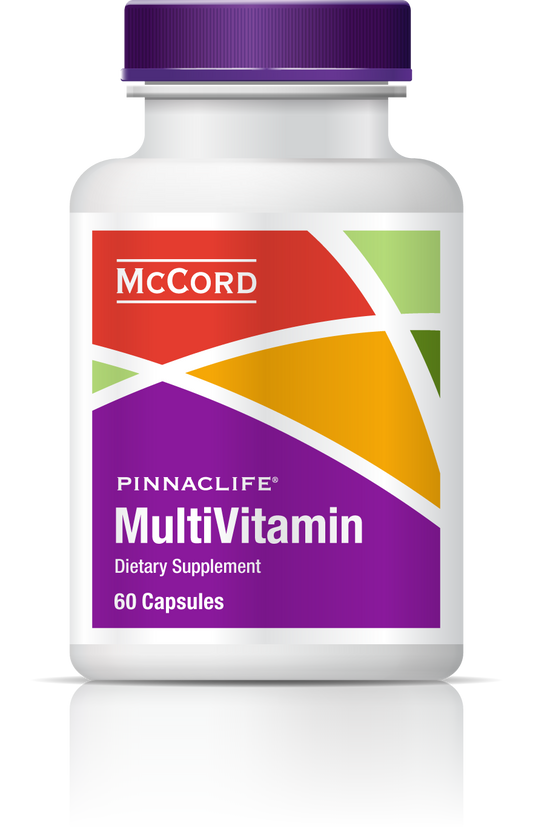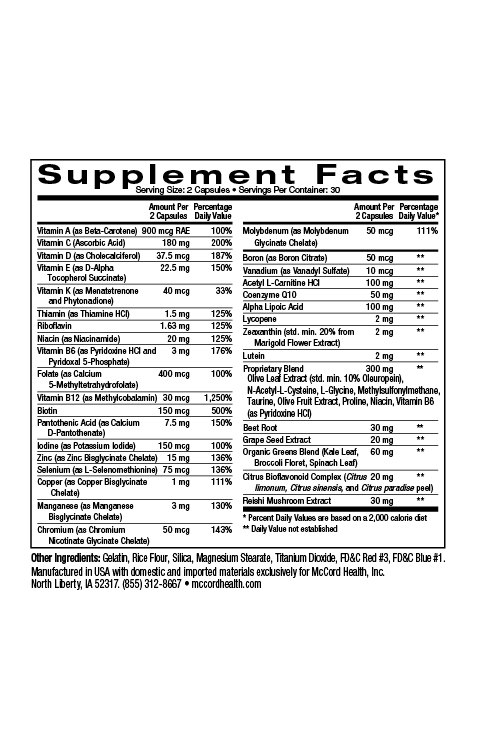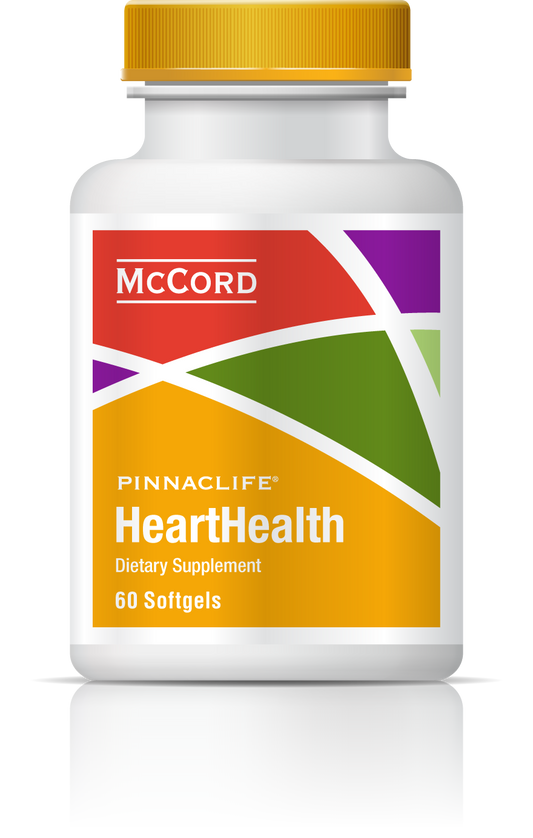Taurine is involved in many neurological activities and is also a powerful antioxidant that protects neurons from toxicities. Inflammation is associated with neurological diseases like Alzheimer’s and taurine has potent anti-inflammatory properties. Other Proprietary Blend ingredients protect the brain and can help provide the remedy for maintaining healthy levels of inflammation.
- Taurine has protective activity against stroke
- Taurine is a small molecule that can cross the blood brain barrier (BBB)
- Levels of taurine decline with age
- Taurine has potent antioxidant activity and protects neurons from toxicity
- Taurine is anti-inflammatory and helps protect the brain from aging
Taurine has been dubbed the “wonder molecule” due to its protective activity in the brain against stroke1, but there are many other beneficial activities of this amazing molecule when it comes to protecting the brain. This very special “wonder molecule” has been classified as an amino acid, but it is not a building block for proteins like other amino acids. Unlike typical amino acid molecules, the taurine molecule includes a sulfonate group, which may help give it some of its extraordinary properties2.
Taurine Crosses the Blood Brain Barrier to Provide Nutrition
The blood brain barrier (BBB) protects the brain from many harmful compounds and certain immune cells. Taurine is a small molecule that is capable of crossing the BBB to help protect brain cells3. Taurine is found in Proprietary Blend, a precise fusion of small molecules including the olive polyphenols, hydroxytyrosol and oleuropein. These polyphenols as well as taurine and antioxidants such as N-acetylcysteine (NAC) and methylsulfonylmethane (MSM) are combined in Proprietary Blend with additional nutrients including vitamins and other amino acids to provide strengthening nutrition to cells.
Taurine is very abundant in the brain and in other tissues, in fact it is the second most abundant amino acid in the brain besides glutamate2, but its levels in the brain decline with age, which may affect certain brain functions. Nutritional scientists often consider it as conditionally essential because our bodies can normally make it and it’s mainly found in meat and fish, which some people including vegetarians or vegans don’t consume2,4. Individuals with certain health conditions including diabetes and kidney failure also have low levels of taurine that should benefit from supplementation5,6.
Taurine is involved in many neurological activities including the regulation of neural excitability, the maintenance of cerebellar functions and the regulation of motor performance, which is conveyed through its interactions with receptors for neurotransmitters such as for serotonin and dopamine, as well as its interactions with glutamate. Taurine is found in all types of cells in the brain including neurons. It’s required for neuronal growth and in fact, high levels of taurine are found in developing brains, but by the time our brains mature, levels have already declined to 30% of the original concentrations2,7.
Potent Antioxidant Activity
One of the important ways taurine is thought to protect neurons is through its own potent antioxidant activity. Taurine is capable of counteracting oxidative stress that has been linked with neurological damage and neurodegeneration8. Active brain cells have hundreds to thousands of mitochondria, the energy powerhouses of cells. Taurine’s antioxidant activity contributes to improved mitochondrial function. Damage or dysfunctional mitochondria can result in increased oxidative stress that has been associated with neurological diseases including Alzheimer’s and Parkinson’s disease9,10.
Other small molecules in Proprietary Blend also have antioxidant activity including hydroxytyrosol, oleuropein, NAC, MSM and vitamin B611-16. In fact, some of these beneficial ingredients stimulate natural antioxidants and antioxidant defense enzymes that counteract oxidative stress including superoxide dismutase (SOD). Hydroxytyrosol, activates an important transcription factor, FOXO3a that turns on manganese SOD (MnSOD)17, and it also up-regulates the important antioxidant enzyme, heme oxygenase-1 (HO-1)18. In a model where MnSOD was deactivated, oleuropein induced MnSOD activity19.In addition, N-acetyl-L-cysteine activates MnSOD20. Hydroxytyrosol, NAC and MSM have also been shown to increase levels of the important antioxidant glutathione13,21,22.
Taurine has been shown to protect neurons from toxicity associated with various pesticides including rotenone, paraquat and chlorpyrifos23-25, as well as other toxic substances such as lead, ammonia and alcohol4. Brain injury can result in glutamate release from neurons known as excitotoxicity and it can also result in mitochondrial dysfunction. Taurine has been shown to protect against glutamate excitotoxicity26. In fact, taurine levels in the brain normally increase under stressful conditions to protect the brain. Taurine also helps maintain calcium homeostasis (steady-states) that helps protect brain cells and mitochondria from damage27.
Cellular (including brain cell) damage often leads to inflammation, which is also associated with neurodegenerative diseases like Alzheimer’s and Parkinson’s disease10. Taurine has been shown to have potent anti-inflammatory effects that decrease the production of pro-inflammatory chemical messengers known as cytokines following stroke and traumatic brain injury26. In addition to taurine, Olivamine® includes other potent anti-inflammatory small molecules such as hydroxytyrosol, NAC and MSM that are capable of crossing the BBB to help decrease inflammation28-34.
Protecting Neurons and the Brain from Aging
Taurine protects neurons and the brain from the aging process. Aging can be associated with decreased locomotion, memory and sensory performance. In addition, aging is associated with increased oxidative stress, neurodegeneration and decreased GABA (gamma-aminobutyric acid) neurotransmission, which is important for nerve cell functioning in all areas of the brain. Interestingly, taurine consumption has been shown to increase GABA levels in brains27. Taurine consumption has also been found to recover learning and memory in models of Alzheimer’s disease and in a model of sub-chronic toxicity exposure8,35,36.
Taurine protects neurons and the brain in numerous ways and it acts synergistically with other Proprietary Blend molecules that protect the brain and support brain health including hydroxytyrosol, NAC, MSM and vitamin B6. In addition, BrainHealth with Proprietary Blend includes more ingredients that are important for maintaining healthy brain cells and proper brain functioning including curcumin, magnesium, and folate (vitamin B9), vitamin D and sulforaphane found in broccoli. BrainHealth includes impeccably sourced ingredients that have undergone rigorous scientific review to prove we renew, restore and repair cells.
References
- J Biomed Sci 2010; 17(Suppl 1): S6, 1-14.
- Int J Pharma Res Health Sci 2015; 3(3): 80-686.
- Molec Neurodegen 2009; 4: 47-59.
- Clev Clin J Med 2016; 83: 895-904.
- Nutr Hosp 2002; 17(6): 262-270.
- Food Chem Toxicol 2014; 71: 116-121.
- Mol Vision 2012; 18: 2673-2686.
- Neurol Sci 2013; 34(12): 2181-2192.
- J Cell Sci 2006; 119: 2855-2862.
- Curr Neuropharmacol 2009; 7: 65-74.
- J Agric Food Chem 2011; 59: 4473-4482.
- Sci Pharm 2010; 78: 133-154.
- Amino Acids 2004; 26: 203-207.
- Nutrients 2017; 9(3): 290:1-21.
- Life Sci 2015; 121: 110-116.
- Front Genet 2018; 9: 388: 1-5.
- Age 2012; 34: 95-109.
- Genes Nutr 2012; 7: 343-355.
- J Biol Regul Homeost Agents 2014; 28: 105-116.
- Cancer Res 2007; 67: 6392-6399.
- Eur J Pharmacol 2017; 811: 240-248.
- Front Genet 2018; 9: 388: 1-5.
- Brain Res 2015; 1622: 409-13.
- Amino Acids 2018; 50(5): 547-556.
- Environ Toxicol Pharmacol 2014; 37: 315-325.
- Amino Acids 2016; 48: 2169-2177.
- Amino Acids 2013; 45: 735-750.
- Adv Exp Med Biol 2013; 175: 19-27.
- Adv Exp Med Biol 2000; 483: 321-324.
- Planta Med 2011; 77: 1890-1897.
- Int J Mol Sci 2017; 18(11): 2230: 1-27.
- J Biomed Sci 2017; 24:71: 1-15.
- J Prev Alzhemers Dis 2017; 4(3):201-206.
- Nutrients 2017; 9: 290: 1-21.
- Sci Rep 2014; 4: 7467: 1-7.
- J Biomed Sci 2014; 21: 51: 1-8.

